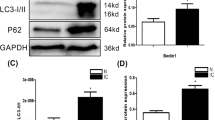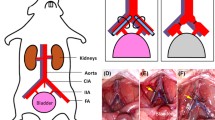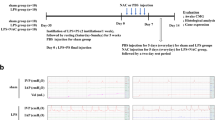Abstract
It has been demonstrated that increases in poly(ADP-ribose) polymerase (PARP) activity causes damage to several organs under ischemia/reperfusion (I/R) conditions. The aims of this study were to investigate whether inhibition of PARP could suppress apoptosis in the bladder following acute urinary retention (AUR) and subsequent bladder emptying. Twelve-week-old male Sprague Dawley rats were divided into a control group, saline treated group, and 3-aminobenzamide (3-AB, a specific PARP inhibitor)-treated group. Sixty minutes after the administration of saline and 3-AB, the saline and 3-AB-treated groups had 60 min of over-distension and followed by 2 h of drainage. The degree of bladder apoptosis, levels of malondialdehyde (MDA), ATP and nicotinamide adenine dinucleotide (NAD+); expression of poly(ADP-ribose) (PAR), phosphorylation of protein kinase B (Akt); and levels of Bcl-2, Bax, and caspase 3 activity in the bladder were determined. Molecular and histological analyses showed that bladder apoptosis was associated with increases in the amount of PAR and decreases in ATP and NAD+ levels in the saline treated group. In addition, phosphorylated Akt and Bcl-2/Bax ratio were significantly decreased. The activity of caspase 3 was significantly increased in the saline treated group. Inhibition of PARP significantly increased the levels of ATP and NAD+, phosphorylation of Akt, and Bcl-2/Bax ratio, and significantly reduced the activation of caspase 3. As a result, apoptosis in the bladder was attenuated. These results indicate that PARP activation may be involved in apoptosis in the bladder induced by AUR and subsequent emptying via energy depletion and suppression of Akt activity.



Similar content being viewed by others
References
Saito M, Miyagawa I (2001) Bladder dysfunction after acute urinary retention in rats. J Urol 165:1745–1747
Lin AT, Chen KK, Yang CH, Chang LS (2000) Mannitol facilitates rabbit urinary bladder recovery from overdistension injury. Urology 56:702–707
Shimizu S, Saito M, Kinoshita Y, Kazuyama E, Tamamura M, Satoh I et al (2009) Acute urinary retention and subsequent catheterization cause lipid peroxidation and oxidative DNA damage in the bladder: preventive effect of edaravone, a free-radical scavenger. BJU Int 104:713–717
Saito M, Miyagawa I (2002) N(G)-nitro-l-arginine methylester, a nitric oxide synthase inhibitor, diminishes apoptosis induced by ischemia-reperfusion in the rat bladder. Neurourol Urodyn 21:566–571
Yu HJ, Chien CT, Lai YJ, Lai MK, Chen CF, Levin RM et al (2004) Hypoxia preconditioning attenuates bladder overdistension-induced oxidative injury by up-regulation of Bcl-2 in the rat. J Physiol 554:815–828
Hong SK, Son H, Kim SW, Oh SJ, Choi H (2005) Effect of glycine on recovery of bladder smooth muscle contractility after acute urinary retention in rats. BJU Int 96:1403–1408
Bratslavsky G, Kogan BA, Matsumoto S, Aslan AR, Levin RM (2003) Reperfusion injury of the rat bladder is worse than ischemia. J Urol 170:2086–2090
Saito M, Wada K, Kamisaki Y, Miyagawa I (1998) Effect of ischemia-reperfusion on contractile function of rat urinary bladder: possible role of nitric oxide. Life Sci 62: PL149–156
Ohnishi N, Liu SP, Horan P, Levin RM (1998) Effect of repetitive stimulation on the contractile response of rabbit urinary bladder subjected to in vitro hypoxia or in vitro ischemia followed by reoxygenation. Pharmacology 57:139–147
Juan YS, Chuang SM, Kogan BA, Mannikarottu A, Huang CH, Leggett RE et al (2009) Effect of ischemia/reperfusion on bladder nerve and detrusor cell damage. Int Urol Nephrol 41:513–521
Virag L (2005) Structure and function of poly(ADP-ribose) polymerase-1: role in oxidative stress-related pathologies. Curr Vasc Pharmacol 3:209–214
Liu R, Gao M, Yang ZH, Du GH (2008) Pinocembrin protects rat brain against oxidation and apoptosis induced by ischemia-reperfusion both in vivo and in vitro. Brain Res 1216:104–115
Wu HH, Hsiao TY, Chien CT, Lai MK (2009) Ischemic conditioning by short periods of reperfusion attenuates renal ischemia/reperfusion induced apoptosis and autophagy in the rat. J Biomed Sci 16:19
Sodhi RK, Singh M, Singh N, Jaggi AS (2009) Protective effects of caspase-9 and poly(ADP-ribose) polymerase inhibitors on ischemia-reperfusion-induced myocardial injury. Arch Pharm Res 32:1037–1043
Li WJ, Shin MK, Oh SJ (2010) Time dependent bladder apoptosis induced by acute bladder outlet obstruction and subsequent emptying is associated with decreased MnSOD expression and Bcl-2/Bax ratio. J Korean Med Sci 25:1652–1656
Bozlu M, Coşkun B, Cayan S, Acar D, Aktaş S, Ulusoy E et al (2004) Inhibition of poly(adenosine diphosphate-ribose) polymerase decreases long-term histologic damage in testicular ischemia-reperfusion injury. Urology 63:791–795
Chiu J, Farhangkhoee H, Xu BY, Chen S, George B, Chakrabarti S (2008) PARP mediates structural alterations in diabetic cardiomyopathy. J Mol Cell Cardiol 45:385–393
Virag L, Szabo C (2002) The therapeutic potential of poly(ADP-ribose) polymerase inhibitors. Pharmacol Rev 54:375–429
Szijarto A, Batmunkh E, Hahn O, Mihaly Z, Kreiss A, Kiss A et al (2007) Effect of PJ-34 PARP-inhibitor on rat liver microcirculation and antioxidant status. J Surg Res 142:72–80
Ha HC, Snyder SH (1999) Poly(ADP-ribose) polymerase is a mediator of necrotic cell death by ATP depletion. Proc Natl Acad Sci USA 96:13978–13982
Beneke S, Diefenbach J, Burkle A (2004) Poly(ADP-ribosyl)ation inhibitors: promising drug candidates for a wide variety of pathophysiologic conditions. Int J Cancer 111:813–818
Tapodi A, Debreceni B, Hanto K, Bognar Z, Wittmann I, Gallyas F et al (2005) Pivotal role of Akt activation in mitochondrial protection and cell survival by poly(ADP-ribose)polymerase-1 inhibition in oxidative stress. J Biol Chem 280:35767–35775
Veres B, Gallyas F Jr, Varbiro G, Berente Z, Osz E, Szekeres G et al (2003) Decrease of the inflammatory response and induction of the Akt/protein kinase B pathway by poly-(ADP-ribose) polymerase 1 inhibitor in endotoxin-induced septic shock. Biochem Pharmacol 65:1373–1382
Kovacs K, Toth A, Deres P, Kalai T, Hideg K, Gallyas F Jr et al (2006) Critical role of PI3-kinase/Akt activation in the PARP inhibitor induced heart function recovery during ischemia-reperfusion. Biochem Pharmacol 71:441–452
Mathieu J, Flexor M, Lanotte M, Besancon F (2008) A PARP-1/JNK1 cascade participates in the synergistic apoptotic effect of TNFalpha and all-trans retinoic acid in APL cells. Oncogene 27:3361–3370
Manning BD, Cantley LC (2007) AKT/PKB signaling: navigating downstream. Cell 129:1261–1274
Roos WP, Kaina B (2006) DNA damage-induced cell death by apoptosis. Trends Mol Med 12:440–450
Kuwana T, Newmeyer DD (2003) Bcl-2-family proteins and the role of mitochondria in apoptosis. Curr Opin Cell Biol 15:691–699
Emberton M, Fitzpatrick JM (2008) The Reten-World survey of the management of acute urinary retention: preliminary results. BJU Int 101(3):27–32
Zaremba T, Curtin NJ (2007) PARP inhibitor development for systemic cancer targeting. Anticancer Agents Med Chem 7:515–523
Shimoda K, Murakami K, Enkhbaatar P, Traber LD, Cox RA, Hawkins HK et al (2003) Effect of poly(ADP ribose) synthetase inhibition on burn and smoke inhalation injury in sheep. Am J Physiol Lung Cell Mol Physiol 285:L240–L249
Garcia Soriano F, Virag L, Jagtap P, Szabo E, Mabley JG, Liaudet L et al (2001) Diabetic endothelial dysfunction: the role of poly(ADP-ribose) polymerase activation. Nat Med 7:108–113
Southan GJ, Szabo C (2003) Poly(ADP-ribose) polymerase inhibitors. Curr Med Chem 10:321–340
Bryant HE, Helleday T (2004) Poly(ADP-ribose) polymerase inhibitors as potential chemotherapeutic agents. Biochem Soc Trans 32:959–961
Lee TM, Su SF, Suo WY, Lee CY, Chen MF, Lee YT et al (2000) Distension of urinary bladder induces exaggerated coronary constriction in smokers with early atherosclerosis. Am J Physiol Heart Circ Physiol 279:H2838–H2845
Yu HJ, Lin BR, Lee HS, Shun CT, Yang CC, Lai TY et al (2005) Sympathetic vesicovascular reflex induced by acute urinary retention evokes proinflammatory and proapoptotic injury in rat liver. Am J Physiol Renal Physiol 288:F1005–F1014
Chen SS, Chen WC, Hayakawa S, Li PC, Chien CT (2009) Acute urinary bladder distension triggers ICAM-1-mediated renal oxidative injury via the norepinephrine-renin-angiotensin II system in rats. J Formos Med Assoc 108:627–635
Acknowledgment
This study was supported by grant No. 04-2009-020-0 from the Seoul National University Hospital Research Fund.
Conflict of interest
None.
Author information
Authors and Affiliations
Corresponding author
Rights and permissions
About this article
Cite this article
Li, W.J., Oh, SJ. PARP inhibition prevents oxidative injury of bladder induced by acute urinary retention and subsequent emptying. Apoptosis 16, 574–580 (2011). https://doi.org/10.1007/s10495-011-0588-y
Published:
Issue Date:
DOI: https://doi.org/10.1007/s10495-011-0588-y




